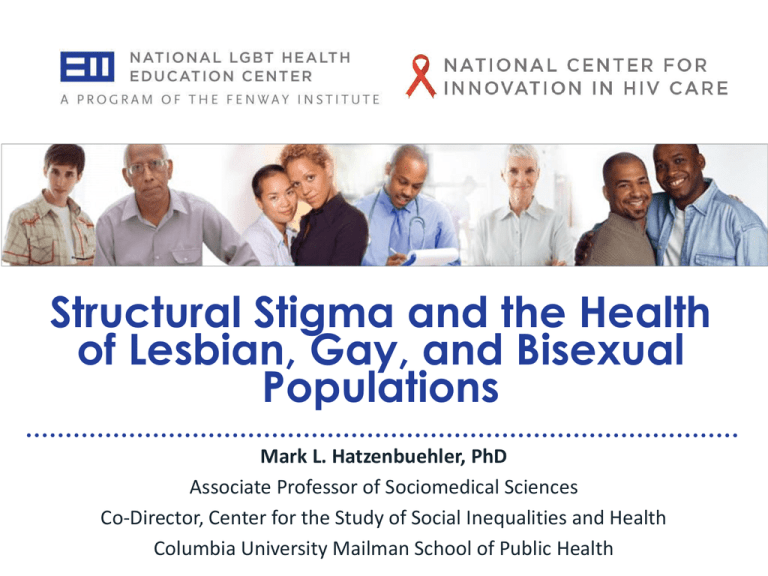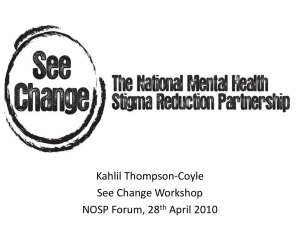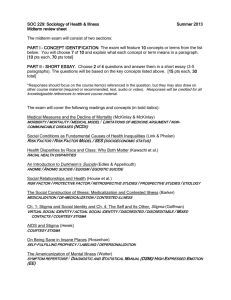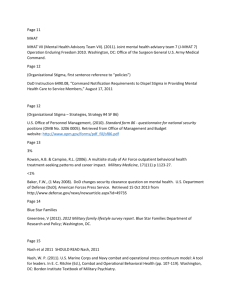
Structural Stigma and the Health
of Lesbian, Gay, and Bisexual
Populations
Mark L. Hatzenbuehler, PhD
Associate Professor of Sociomedical Sciences
Co-Director, Center for the Study of Social Inequalities and Health
Columbia University Mailman School of Public Health
Continuing Medical Education
Disclosure
Program Faculty: Mark L. Hatzenbuehler, PhD
Current Position: Associate Professor, Sociomedical Sciences, Co-Director,
Center for the Study of Social Inequalities and Health, Columbia University
Disclosure: No relevant financial relationships. Presentation does not include
discussion of off-label products.
It is the policy of The National LGBT Health Education Center, Fenway Health that all CME planning
committee/faculty/authors/editors/staff disclose relationships with commercial entities upon
nomination/invitation of participation. Disclosure documents are reviewed for potential conflicts of interest and,
if identified, they are resolved prior to confirmation of participation. Only participants who have no conflict of
interest or who agree to an identified resolution process prior to their participation were involved in this CME
activity.
Learning Objectives
By the end of this session, learners will be able to:
1. Define structural stigma and distinguish it from other
forms of stigma
2. Describe the role of structural stigma as a determinant
of LGB health and health disparities.
3. Discuss ways to integrate research on individual and
structural forms of stigma into clinical settings to
improve the health outcomes and access to care for
LGB patients.
Sexual Orientation Health
Disparities
What is Stigma?
(Link & Phelan, 2001, “Conceptualizing Stigma”)
Stigma involves the co-occurrence of several
overlapping components, including:
Distinguishing and labeling group differences
Associating differences with negative attributes (i.e.,
stereotyping)
Separating “us” from “them”
Status loss and discrimination
In a context of power
Stigma: A Multi-Level Construct
“Societal-level
conditions, cultural
norms, and
institutional policies
and practices that
constrain the
opportunities,
resources, and
wellbeing of the
stigmatized”
(Hatzenbuehler &
Link, 2014, p. 1).
Structural
State Policies, Institutional Practices
Interpersonal
Abuse, Rejection, Discrimination
Individual
Self-Stigma, Concealing
“The underrepresentation of
[structural stigma] is
a dramatic
shortcoming in the
literature on stigma,
as the processes
involved are likely
major contributors
to unequal
outcomes”
(Link et al., 2004, p.
515).
Multi-measure, multi-method
approach to studying structural
stigma and LGB health
Measures of structural stigma:
Social policies (e.g., same-sex marriage laws)
Social attitudes
Social behaviors (e.g., LGBT assault hate crimes)
Methods:
Observational designs (cross-sectional, longitudinal)
Quasi-experimental designs
Laboratory designs
Approach #1: Cross-Sectional, Country-Level
Are Health Problems Elevated among LGB Populations
in High-Structural Stigma Countries?
Country-Level Structural Stigma
Policy index from International LGBTI Association
European Men Who Have Sex
with Men Internet Survey (EMIS)
Linked ecologic data on structural stigma at the country level
(N=38 European countries) to individual-level HIV risk outcomes
among MSM living in these countries (n=174,209 MSM)
Concealment: “Thinking about all the people who know you
(including family, friends and work or study colleagues), what
proportion know that you are attracted to men?”
Response options: all or almost all; more than half; less than half; few;
none
Participants reporting “few” or “none” were classified as high
concealment
Structural Stigma Associated with HIV
Risk Outcomes via Concealment
Outcomes
AOR (95% CI)
AOR (95% CI),
controlling for
concealment
Inadequate HIV
prevention reach
1.43 (1.27-1.62)***
1.34 (1.19-1.50) ***+
Incorrect HIV
transmission knowledge
1.16 (1.08-1.26)***
1.11 (1.03-1.20)*+
No HIV test result (12
mo.)
1.14 (1.05-1.24)**
1.04 (0.96-1.13) +
No STI screen (12 mo.)
1.21 (1.07-1.36)**
1.12 (0.99-1.26) +
Condoms never/seldom
used
1.30 (1.10-1.54)**
1.28 (1.09-1.51)**+
No sex/MSM discussion
when tested
1.52 (1.29-1.80)***
1.39 (1.17-1.65)***+
Covariates: Age, relationship status, employment status, education, settlement size, HIV status, Gini index.
** p ≤ .01, *** p ≤ .001, + significant mediation via distribution-of-the-product method
Approach #1b: Cross-Sectional
Are Health Problems Elevated
among LGB Populations in HighStructural Stigma States?
Measure of Structural Stigma:
State-Level Policies
(1) Hate Crimes
(2) Employment
Discrimination
Red = States with no protective policies
Blue = States with at least one protective policy
National Epidemiologic Survey
on Alcohol and Related
Conditions (NESARC)
Wave 2 (N=34,653)
Household and group
residents
Face-to-face interviews
Response rate: 81%
Oversampling of Blacks,
Hispanics, young adults
(18-24 yrs)
DSM-IV diagnoses
Sexual orientation (1.67%
LGB-identified [1.86%
men, 1.52% women])
Sexual orientation disparity in
psychiatric morbidity is higher in
states with structural stigma
5
4.5
4
3.5
AOR
3
Protective Policies
2.5
No protective policies
2
1.5
1
0.5
0
Dysthymia
GAD
PTSD
Comorbidity
Covariates: sex, age, race/ethnicity, SES,
marital status, perceived discrimination
Approach #2: Longitudinal
Does Structural Stigma Prospectively
Predict Health Problems among LGB
Populations?
Data Sources:
General Social Survey/National Death Index
General Social Survey (GSS)
Primary source of social indicator data for social sciences since 1972
Repeated cross-sectional surveys (N=53,043 from 1972-2008)
Representative sample of the US non-institutionalized population
Measure of sexual behavior (N=914 sexual minorities; 4.5%)
National Death Index (NDI)
Participants from 18 waves of GSS are linked prospectively to mortality
data by cause of death, obtained from National Death Index
Linkage approach well-validated (e.g., NHANES, NHIS)
General Social Survey/National Death Index:
Community-Level (N=170 PSUs) Prejudicial Attitudes as
a Predictor of Mortality Risk among Sexual Minorities
San Francisco (n=75)
Prejudicial attitudes=0.9
20 sexual minorities
2 died
Shelby County (n=20)
Prejudicial attitudes=3.2
2 sexual minorities
1 died
Structural Stigma Predicts Increased
Mortality Risk Adjusting for Individual
and Community-Level Risk Factors
Parameters
Hazard Ratio
95% Confidence Interval
Structural Stigma
3.03
(1.50, 6.13)**
Sex (Female)
0.59
(0.39, 0.88)**
Race/Ethnicity (Black)
2.87
(1.76, 4.67)***
Age at Interview
1.05
(1.04, 1.06)***
Years of Education
0.99
(0.93, 1.05)
Household Income
1.04
(0.86, 1.86)
Self-Rated Health (Poor/Fair)
1.04
(0.61, 1.19)
Community-Level Income
1.70
(0.56, 5.17)
Community-Level Education
0.86
(0.61, 1.19)
Life expectancy difference = 12 yrs. (range: 4-20)
**p<0.01, ***p<0.001
Survival Time by CommunityLevel Structural Stigma
100%
Low Structural Stigma
Percent Alive
95%
90%
85%
80%
75%
High Structural Stigma
70%
1
2
4
5
6
7
8
9
10 11 12 13 14 15 16 17 18 19 20 22
Time, years
Additional Results
Descriptive analyses of specific causes of death by ICD-9 code:
Results were not due to HIV-related causes (only 5 deaths)
Suicide, homicide/violence, and cardiovascular diseases were
substantially elevated among sexual minorities in high-structural stigma
communities
Sexual minorities in high-stigma communities died by suicide at age 37.5
vs. 55.7 among those in low-stigma communities (18-year difference)
Testing alternative explanations
Geographic mobility since age 16 is not associated with:
Self-rated health: r=0.02, p=.16
Mortality risk: HR=1.17 (95% CI: 0.76, 1.78)
Results are robust to selection effects regarding mobility
Approach #3a: Quasi-Experimental
Do Health Problems among LGB
Populations Increase Following
Increases in Structural Stigma?
Constitutional Amendments
Banning Same-Sex Marriage
(2004)
Red = States passing
constitutional
amendments
Blue = States not passing
constitutional
amendments
NESARC (2001-2005)
LGB Adults Living in States that Banned
Same-Sex Marriage Experienced
Increase in Mood Disorders
35
36.6% increase
30
23.6% decrease
MOOD DISORDER
25
20
Wave 1
15
Wave 2
10
5
0
Gay Marriage Ban (N=135)
No Marriage Ban (N=442)
STATE OF RESIDENCE
AOR = 1.67 (95% C.I. 1.01, 2.77)
Covariates: sex, age, race/ethnicity, SES, marital status
AOR = 0.69 (95% C.I., 0.47, 1.01)
Effect of Marriage Bans Specific
to LGB Adults
35
36.6% increase
30
MOOD DISORDER
25
2.6% increase
20
Wave 1
Wave 2
15
10
5
0
LGB (N=135)
AOR = 1.67 (95% C.I. 1.01, 2.77)
Heterosexual (N=9,963)
AOR = 1.03 (95% C.I. 0.93, 1.15)
Covariates: sex, age, race/ethnicity, SES, marital status
Approach #3b: Quasi-Experimental
Do Health Problems among LGB
Adults Decrease Following
Reductions in Structural Stigma?
Methods
In 2003, Massachusetts became the first state to
legalize same-sex marriage (Goodridge vs. Department
of Public Health)
Community-based health clinic (N=1,211 gay and
bisexual men)
Extracted health information in outpatient billing
records from 2002-2004
Examined changes in medical and mental health care
utilization and expenditures in the 12 months before
and after same-sex marriage legalized
Reduction in Mental Health Care
Utilization in the 12 Months Following
Same-Sex Marriage
25
24.5
24
# OF VISITS
23.5
23
22.5
22
21.5
21
20.5
Pre-Marriage Law
Post-Marriage Law
F(1,147)=4.60,
p=0.03,
Cohen’s d=0.35
Reduction in Mental Health Care
Costs in the 12 Months Following
Same-Sex Marriage
2450
2400
2350
Costs
(in $)
COSTS (IN $)
2300
2250
2200
2150
2100
2050
2000
1950
Pre-Marriage Law
Post-Marriage Law
F(1, 147)=6.32,
p<0.01,
Cohen’s d=0.41
Reduction in Health Problems in 12
Months Following Same-Sex Marriage
(by International Classification of Diseases-9 codes)
20
18
16
% REDUCTION
14
12
10
8
6
4
2
0
Depression
Adjustment
Hypertension
Addressing Alternative Explanations:
Health Care in Massachusetts (2002-2004)
Instituted comprehensive health care reform law
But this occurred in 2006, well outside the study period
Trends in health care costs among Massachusetts residents
increased during study period (CMS, 2007)
But we find evidence for decreased expenditures
Cuts to MassHealth insurance program (disabilities, poverty) in
2004
But only 3% of our sample had MassHealth; removing them doesn’t
change direction or magnitude of the results
Approach #4: Laboratory paradigms
to test mechanisms
Does Structural Stigma Alter HPA Axis
Functioning?
Participants
74 LGB young adults from 24 states
Age: M=23.68, SD=4.12
54% female
57% lesbian/gay
60% non-White
Told purpose of study was to “understand connections
between daily experiences, your bodily activity, and
health”
Structural Stigma Measure
Lower scores (lighter blue) indicate higher structural stigma
Ranges from low of -4.46 (Mississippi) to 7.90 (Massachusetts)
Density of same-sex partner
households (Census)
Proportion of GSAs in public
high schools (GLSEN)
5 state-level policies (e.g.,
hate crimes, ENDA, same-sex
marriage)
Composite index of attitudes
from 41 national opinion polls
(Lax & Phillips, 2009)
Factor Analysis (loadings
range from .79 to .97)
Methods
Procedure:
Trier Social Stress Test (Kirschbaum et al., 1993)
5-minute speech (identity-relevant topic) in front of 2 evaluators
(confederates), followed by 5-minute math task
Collect neuroendocrine samples (cortisol) before, during, and after
speech and math tasks
Structural stigma associated with
blunted cortisol reactivity to Trier
Social Stress Test
14
12
Cortisol nmol/L
10
8
Low Structural Stigma
6
High Structural Stigma
4
2
0
Time 1
Time 2
Time 3
Cortisol Area Under Curve (AUC) for low structural stigma: adjusted M=124.68
Cortisol AUC for high structural stigma: adjusted M=62.68
Structural stigma associated with
HPA axis reactivity independent of
perceived stigma
Parameters
F-statistic
P-value
Structural Stigma
4.45
0.039
Sex
7.83
0.007
Age
2.01
0.161
Waking Time
4.46
0.039
Smoking
0.96
0.331
Exercise
1.12
0.294
Race
0.66
0.418
Caffeine Use
0.02
0.882
Individual-Level Stigma
3.39
0.071
Interpretations
Blunted cortisol response also observed in:
Youths exposed to extreme life stressors (e.g., childhood
maltreatment; Carpenter et al., 2007)
Individuals with PTSD and other forms of severe trauma
(e.g., Yehuda et al., 2000)
Females who were randomly assigned to an ostracism
condition (Zwolinski, 2012)
The stress of growing up in high-stigma environments
may exert biological effects that are similar to other
chronic life stressors
Conclusion:
Structural Stigma as a Risk Indicator
for Poor Health
Structural
State Policies, Institutional Practices
Interpersonal
Abuse, Rejection, Discrimination
Individual
Self-Stigma, Disclosure
Future Directions for Structural
Stigma and LGB Health Research
Evaluate relationships between different forms of
stigma across different levels of analysis
Mediation: Structural Individual Health
Recommendations
Develop greater awareness of stigma as an etiologic factor that
contributes to the health of LGB populations, which is necessary
for provision of appropriate care
Develop multi-component interventions that address stigma at
each level
Individual level: Cognitive-Behavioral Therapy to reduce negative mental
health consequences of stigma (e.g., Pachankis et al., 2015)
Interpersonal level: reduce stigma in interpersonal interactions (e.g.,
mental health counselors; Rutter et al., 2008)
Structural level: Addressing the broad social context (e.g., laws, social
norms) in which LGB individuals are embedded (Hatzenbuehler, 2014)
Acknowledgments
Funders
National Institute on Drug Abuse (K01 DA032558)
National Institute of Mental Health (F31 MH834012)
American Public Health Association (Walter J. Lear Award, Kenneth Lutterman
Award)
American Psychological Association (Maylon-Smith Dissertation Award)
Williams Institute at UCLA School of Law (small research grant)
Robert Wood Johnson Foundation
Center for Population Research In LGBT Health
Collaborators
Bruce Link, Jo Phelan, Katherine Keyes, Deborah Hasin (Columbia)
Kate McLaughlin (University of Washington)
Jack Dovidio, Susan Nolen-Hoeksema (Yale)
Steve Safren, Ken Mayer, Judy Bradford, Conall O’Cleirigh (Fenway)






